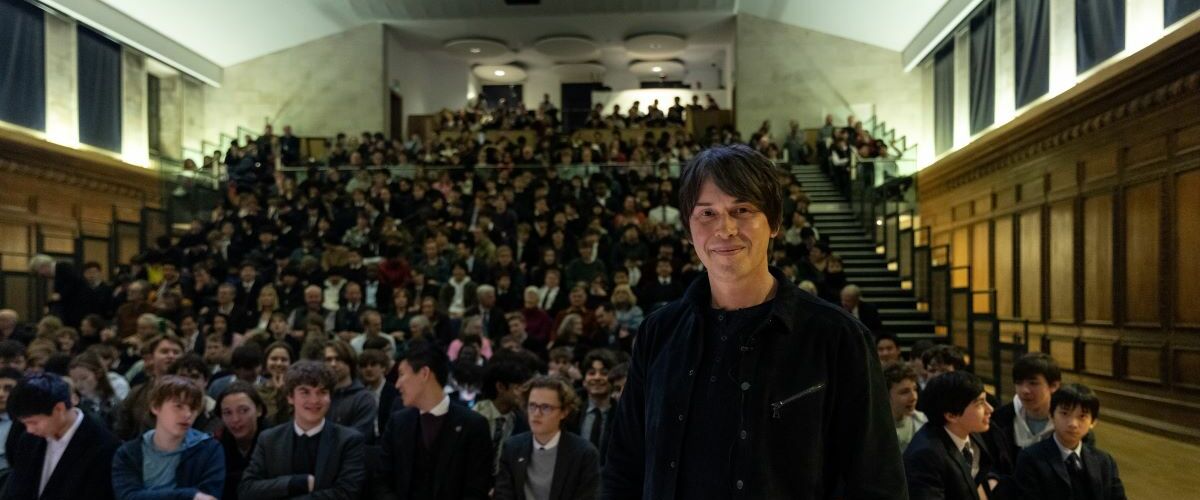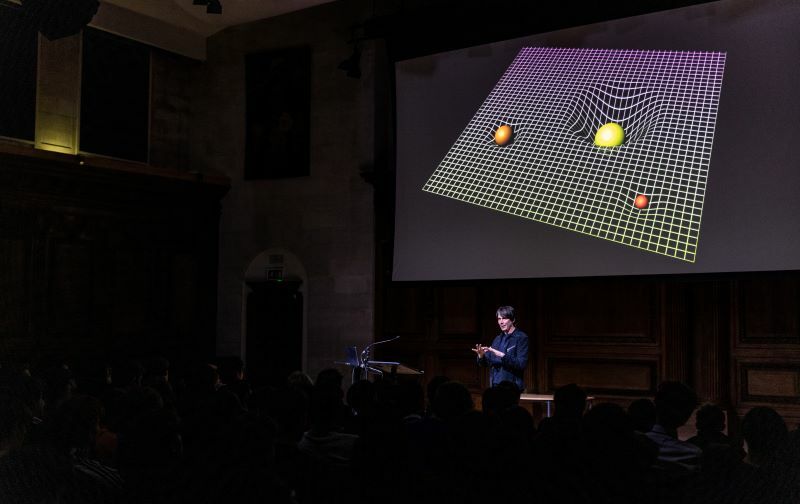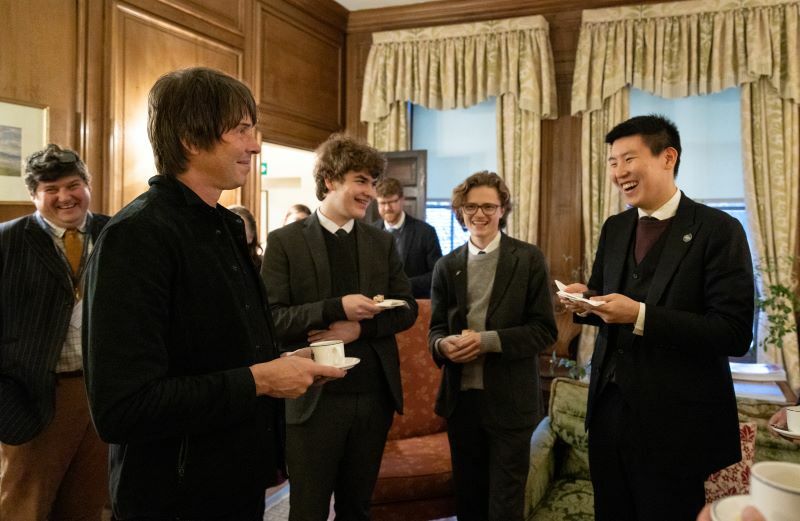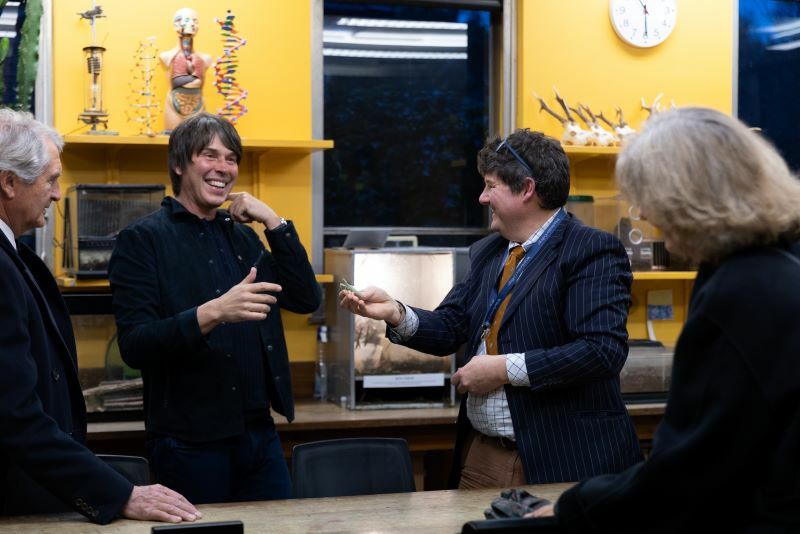

A Natural History of the Universe
The End of Time
Speaking to 400 pupils on 8 March for the annual Duncan Louis Stewart Natural History Lecture, Professor Brian Cox CBE FRS explained how the most exotic objects in the universe – Black Holes – might actually be the purest, simplest expression of the fundamental laws that govern our universe. On this grandest of canvas of possibly a hundred billion trillion stars and their associated planetary systems, the conditions for complex life to arise may be incredibly rare, perhaps less than one civilization per galaxy on average. But there may be more novel ways to transform geology into biology than we experience on Earth. Professor Cox concluded his lecture with the tantalizing hypothesis that exotic life forms might right now be swimming in the saline ocean thought to be hidden beneath the thick ice crust of the Jovian moon Europa, which is continually stretched and heated by an intricate gravitational dance with Jupiter and the moons Io and Ganymede. Within the next few decades, a sequence of space missions will aim to find out whether life on Earth is unique to our solar system.
Professor Cox led the audience through the fundamentals of cosmology and physics, tracing back historically to ideas which led to Einstein’s General Theory of Relativity. This re-imagines the Newtonian idea of planetary orbits within a fixed geometrical system, and replaces it with a notion of motion in a spacetime that is distorted by the presence of mass and energy. This theory explains how light itself can be bent via a gravitational lens. Cox showed an extraordinary image of the light from very distant galaxies appearing as multiple arcs around a more local (but still very distant!) cluster of galaxies. The most extreme prediction of General Relativity, the concept of a Black Hole, formed a major part of the lecture. A three-dimensional simulation, created for the film Interstellar, of what the distorted environs of a solar-system sized ‘super-massive’ Black Hole might look like, was presented alongside a recent image of the Black Hole at the centre of the M87 galaxy. There were tantalizing similarities.
Beyond the Event Horizon
Professor Cox proposed that scientists are entering a new understanding of space and time, revealed primarily through their study of Black Holes. He noted that, in the last decade particularly, the study of collapsed stars suggest Black Holes are even more fundamental structures than previously thought, and that they might be understood both as the “building blocks of space and the building blocks of time.” Cox addressed the question of what might happen if one fell into a Black Hole. Beyond the Event Horizon it might be the case that time and space exchange meaning, and rather than understanding it as a place in space, he described the centre of a Black Hole as “the end of time”. He pointed out that Stephen Hawking’s theory that Black Holes have a temperature leads us to the “seemingly contradictory nature of Black Holes.” Rather than removing mass, energy and information from the Universe, the Hawking Radiation from a Black Hole might be better understood as the ultimate in data shredding. If humanity becomes pan-galactic in the distant future, it might not have to worry about data protection legislation. Intriguingly, Cox stated that a Black Hole could also be thought of as an enormous Quantum Computer.

Snowstorms of Galaxies
Far from overwhelming his audience, Cox inspires awe when discussing the sheer size and beauty of the universe, sharing stunning images of the Whirlpool Galaxy, for example, to illustrate a galactic collision. He takes unimaginable concepts and makes these clear: enhanced by the very latest photographs from the Planck satellite and elsewhere. His use of poetic language - from the “snowstorm of two trillion galaxies” to the “waterfalls of protons” - makes Cox a particularly engaging speaker, and his subject matter attractive to a much wider audience, beyond the dedicated scientists in the room. However, ultimately this was a talk to inspire the future Stephen Hawkings in the room. The prospect of studying one’s PhD at exactly the time when the data from the imminent Europa mission was returning, in six years time, or being part of the team to send a submarine there in the next decade, was enticing. Many of the questions raised will be answered in the next 20 years or so, possibly by those listening to him that evening.
There was a frisson of excitement amongst pupils leaving the lecture – this was a call to study, to research, to innovate, to explore. But also a rallying cry to protect and cherish the planet we live on. The quest to discover life elsewhere – or a potential environment to support life – may be the holy grail for cosmologists, but there is an urgent need to focus on the changes taking place on Earth and a collective responsibility to address those. It is a humbling and very powerful realization, that our “pale blue dot” could possibly be unique, a glorious statistical anomaly among the billions of solar systems that comprise our galaxy.

Meeting members of the Natural History Society
The Duncan Louis Stewart Legacy
In 2015, the Stewart family and other generous donors endowed Winchester with a fund to support making the natural world relevant to all pupils, in all areas of study, in memory of their son Duncan Stewart (G, 2003-08). Specifically this has included working with a Duncan Louis Stewart Natural History Fellow (DLS NHF) who works alongside all departments to develop pupils’ knowledge of, and respect for, nature, ecology and the environment. In addition, they organise an annual lecture by a renowned expert to attract and encourage polymathic thinking and discussion about our shared natural world. The current DLSNH Fellow is Eve Cavey. Past speakers have included Professor Monica Grady, Jane Goodall and Steve Backshall.


 Head back to stories
Head back to stories